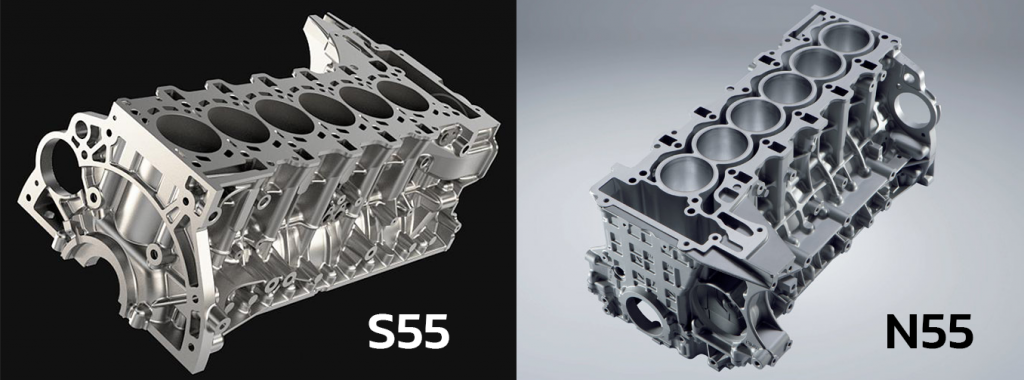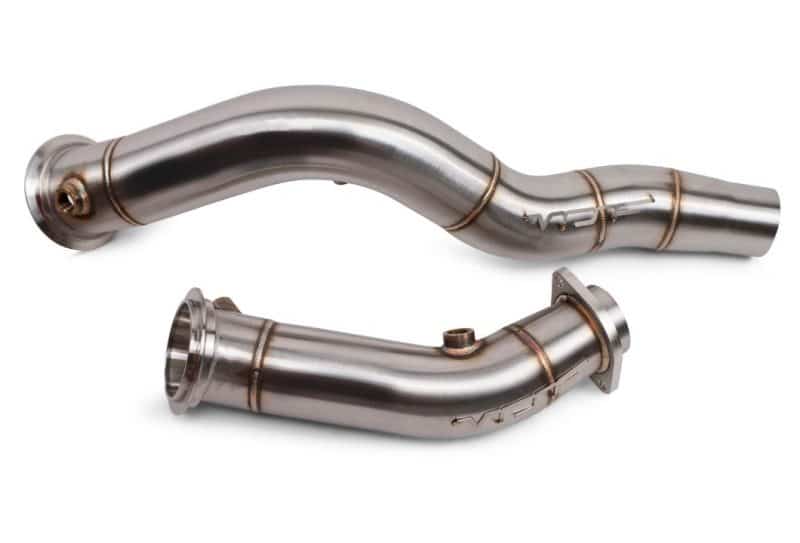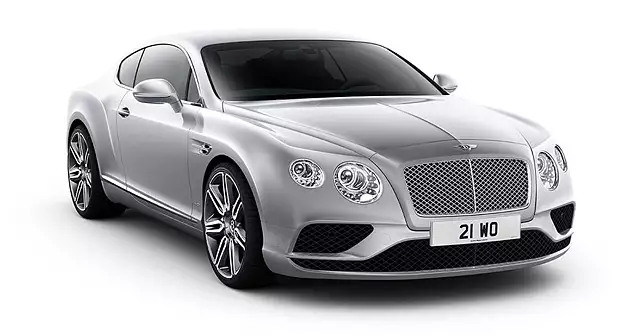BMW S55 Engine Guide – Specs, Reliability, & Modifications
Prior to 2013, plane thinking well-nigh a turbocharged BMW M3 was considered sacrilegious. But, then again, BMW unchangingly brushed controversy whispered when it came to their star child. Surpassing the F80 was the S65 V8-powered E9X M3 which was Judas 1.0 to the M3’s holy inline-6 recipe that began with the E36. Now it has wilt one of the community’s favorites. With a healthy dollop of deja vu, the same word-for-word story repeated a generation later with the F80 M3 and the BMW S55 engine that powered it.
The BMW S55 3.0L turbocharged inline-6 marked a massive turning point for BMW’s M-division and the visitor at large. While BMW had dabbled in high-performance turbocharged M-variants of other engines prior to the S55, like the S63 initially used in the 2010 E70 X5M, the S55 proved that reliable turbocharged performance engines were not only possible to make but moreover the definite way forward. That is remoter evidenced by the fact that BMW had unbearable conviction to guinea pig the S55 in the company’s most famous model.

In this guide, we’ll provide a comprehensive overview of the 3.0L twin-turbocharged BMW S55 inline-6, outlining its specs, upgrades compared to the BMW N55 off which it is based, its overall reliability, and some of the most popular S55 performance modifications.
BMW S55 Engine Specs
Engine: BMW S55 Engine
Configuration: Inline-6 Cylinder
Displacement: 3.0L (2,979 cc)
Aspiration: Twin Mono Scroll Turbocharged
Valvetrain: DOHC, Dual-VANOS, Valvetronic, 4-valves per cylinder
Block/Head: Aluminum
Bore x Stroke: 84.0 mm x 89.6 mm
Compression Ratio: 11.5:1
Engine Weight: 452lbs
Horsepower: 405-493 hp
Torque (lb-ft): 295-406 lb-ft
The BMW S55 is a 3.0L inline-6 engine that utilizes two mono-scroll turbochargers for each wall of three cylinders. Like the N55 engine that it is based on, the S55’s woodcut and cylinder throne are synthetic from aluminum. The S55 engine makes use of a closed-deck engine woodcut for widow rigidity and strength. The BMW S55 is moreover equipped with both VANOS variable valve timing and Valvetronic variable valve lift technology. Many of the S55’s internal and auxiliary components, like the crankshaft, main bearings, and oil pan, were redesigned to save weight and modernize strength.
Overall, the S55’s use of turbo technology and improved engine diamond as a whole gives it a 30% increase in torque and a 28% resurgence in fuel efficiency over the previous S65 V8 found in the E9X M3.
BMW N55 vs S55
It only makes sense that we compare the BMW N55 and S55, as the S55 unexplored 75 percent of its components from the non-M 3.0L turbocharged inline-6. The BMW N55 was introduced four years prior to the S55, in 2009, as a replacement for the beloved, if not sometimes frustrating, BMW N54 engine. The N55 introduced a number of important advances to BMW’s turbocharged inline-6 formula including twin-scroll turbo and Valvetronic variable valve lift technology. These advances would siphon over into the BMW S55 and subsequent turbocharged engines like the BMW B58.
The primary differences between the S55 and older N55 engines can be seen in their woodcut design, cooling system design, turbocharger arrangement, and internal components.
Open Deck vs Sealed Deck Crankcase
The biggest difference between the engines is their crankcase design. While the N55 made use of an unshut deck design, meaning that it featured coolant channels surrounding the cylinders, the S55 utilizes a sealed deck crankcase. While an unshut deck, like the one used on the N55, is unconfined for cooling efficiency and reducing combustion temperatures, it moreover provides the least value of structural support.

The S55’s sealed deck diamond is much increasingly structurally rigid than the N55’s crankcase, meaning that it can withstand higher cylinder pressures and increasingly power as a result. That is moreover one reason for the S55’s increased 7,600 RPM redline. However, with the sealed deck woodcut came the need for a revised cooling system to compensate.
The N55 and S55 moreover differ in terms of their cylinder liners. The N55 previously made use of tint iron cylinder liners which helped to provide the cylinder walls with some widow strength and rigidity. The S55 got rid of these tint iron liners in favor of LDS-coated cylinder liners through a process tabbed electric arc wire spraying. Not only do the S55’s LDS-coated liners provide just as much strength, but they moreover reduced the engine block’s weight by 4.85 lbs.
Cooling System Diamond Differences
Another one of the biggest differences between the N55 engine and the S55 engine is their cooling system designs. As we mentioned before, the S55’s closed-deck crankcase, twin-turbo arrangement, and higher overall performance ceiling, midpoint that it needs a much beefier cooling system than the N55.
The N55 once features a pretty efficient cooling system. Equipped with a main radiator, auxiliary radiator, hot climate oil cooler, and an oil-to-coolant heat exchanger, in combination with the unshut deck crankcase, the N55’s cooling system does a pretty good job of keeping the engine cool.
With that stuff said, the S55’s spare turbo and sealed deck crankcase necessitate a increasingly comprehensive system. The S55’s cooling system is split into two circuits. One is an engine cooling spin and the other is a tuition air cooling system. It moreover includes oil cooling for the engine oil and transmission.

The S55 uses two auxiliary upstream radiators, one for the engine and one for the tuition air spin in wing to a large main radiator for both circuits. The tuition air spin moreover uses an spare indirect tuition air cooler. The turbos are moreover fed coolant by an auxiliary electric coolant pump.
As an spare note, the S55 uses a mechanically driven (belt-driven) water pump for the engine cooling spin instead of the somewhat troublesome electronically driven water pump found on the N54 and N55 engines.
Turbocharger Setup
The S55 moved yonder from the single twin-scroll turbocharger used on the N55 in favor of a increasingly traditional twin parallel Mitsubishi TF035 mono-scroll turbocharger arrangement. The S55 is increasingly like the N54 in that regard, as the N54 was moreover known for its true twin-turbo setup. There are benefits and shortcomings to both a single twin-scroll turbo and a true twin-turbo design.

Twin scroll turbos, like the one found on the N55, are the increasingly efficiency-focused option of the two setups. BMW’s twin-scroll turbo BMW utilizes what’s tabbed a divided inlet turbine. A twin-scroll turbo is divided into two “scrolls,” utilizing an frazzle manifold split into two headers based on firing order.
Ultimately, the N55’s single twin-scroll turbo was designed to subtract uplift lag, create a increasingly plane torque curve, and increase overall engine efficiency. The N55’s twin-power turbo is unquestionably good at what it is supposed to do but it doesn’t leave nearly as much room for aftermarket antics as the S55’s true twin-turbo arrangement.
By using two Mitsubishi TF035 mono-scroll turbochargers, the S55 bridges a fantastic middle ground between performance and efficiency. Ultimately, the S55’s turbo system doesn’t sacrifice much, if any, turbo response to the N55’s twin-scroll turbo while moreover providing largest overall performance. Each turbo is responsible for a wall of three cylinders and the turbos work in parallel. Despite the use of two turbochargers instead of one, the S55’s turbo system is equally as light as the N55’s.
N55 vs S55 Engine Internals/Auxiliary Components
While the BMW S55 unexplored roughly 75% of its components from the N55, there are some very notable differences between the internals of both engines. All of the most important internal components that the S55 borrowed were reworked with strength and weight savings in mind.
We’ll start with the rotating assembly. The S55 is known for having a well-engineered forged steel crankshaft that is not only stronger than the one found in the N55, but moreover 4lbs lighter. The S55’s connecting rods were revised, using a variegated kind of aluminum and a differently shaped sink to help with load distribution. The S55’s pistons are flipside big topic of conversation, as they were moreover redesigned. The S55’s factory Mahle pistons are synthetic from aluminum transfuse for maximum lightness and Grafal coated to prevent friction.
The S55’s oiling system was moreover upgraded to indulge for largest track performance without the risk of oil starvation. In order to provide an uninterrupted spritz of oil virtually the engine, BMW installed a second oil pump, moreover tabbed a suction pump, which supports the return spritz of oil from the turbochargers and the front areas of the oil pan when to the rear of the oil pan. As a result, the S55 is worldly-wise to handle increasingly strenuous acceleration, deceleration, and cornering forces.
What Cars Use the BMW S55 Engine?
As with most other BMW engines, the S55 was offered in variegated trim levels during its build cycle. For example, the Competition and CS variants of the M3, M4, and M2 received higher-output versions of the S55. This difference in power can be attributed to differences in the factory tunes. The only S55 variant that is physically variegated is the one found in the M4 GTS which features a water injection system. Here are the BMWs that make use of the S55 engine with their respective power output:
- 2020–present F87 M2 CS Racing (275-359 horsepower)
- 2019–2021 F87 M2 Competition (405 horsepower)
- 2014–2018 F80 M3 (425 horsepower)
- 2014–2020 F82/F83 M4 (425 horsepower)
- 2016–2018 F80 M3 Competition (444 horsepower)
- 2016–2020 F82/F83 M4 Competition (444 horsepower)
- 2020–2021 F87 M2 CS (444 horsepower)
- 2018 F80 M3 CS (453 horsepower)
- 2017–2020 F82 M4 CS (453 horsepower)
- 2015–2016 F82 M4 GTS (493 horsepower)
- 2017 F82 M4 DTM Champion Edition (493 horsepower)
Stock BMW S55 Engine Performance
Before we jump into how the S55 could potentially perform with the right performance modifications, let’s talk well-nigh the engine in stock form first. Both the minor and major upgrades made to the N55 platform to bring us the S55 were made in pursuit of performance. With the differences in diamond from the previous engine iteration, the BMW S55 moreover displays a number of improved performance characteristics.
One of the most notable elements that gives the S55 largest stock performance than most BMW turbocharged 6-cylinder engines surpassing it is its twin-turbo setup. Combined with dual-VANOS and Valvetronic III variable valve lift, the two small mono-scroll turbos indulge for scrutinizingly firsthand throttle response and instant torque which can be seen on the dyno orchestration below.

The torque lines of a stock S55 typically levels out and stays resulting between 3,000 and 6,000 RPM, which is moreover backed up by dyno results. Overall, those characteristics are pretty similar to what you’d expect to see from an N55, just at a higher performance threshold. Power wordage is moreover extremely linear and predictable, which is something that you’d expect from a naturally aspirated BMW 6-cylinder.
There’s no doubt that the S55 is one of the weightier turbocharged inline-6 engine that BMW has overly made in terms of out-of-the-box performance. In fact, it is wontedly reported that BMW vastly underrated the S55’s peak power output, often stuff much higher than the factory-reported figures. The fact that torque is so firsthand and stays steady through the majority of the rev range ways that you’ll unchangingly have usable grunt under your right foot no matter what.
BMW S55 Reliability
In the beginning, the reliability of BMW’s turbocharged engines was a serious point of contention amongst potential buyers. The N55 was truly one of the first turbo BMW engines that could truly be considered reliable. Luckily, that carried through to the S55 as well. Since the S55 was released 10 years ago, it has proven to be an extremely reliable engine with very few worldwide problems.
BMW S55 Zombie Hub Issues
This S55 “common problem” is a very heated one in the M3/M4 polity and one that has caused a lot of drama and syllogistics in the forums as a result. Essentially, this problem stems from early reports that the M3 and M4, equipped with the S55 engine, were experiencing frequent zombie hub failure.
While there are some reports of this happening, the overall percentage of S55 owners that have experienced this issue is very low. Most of the coverage of this problem has stemmed from aftermarket communities trying to overreport the problem to sell replacement parts that have proven to be plane increasingly rabble-rousing than the factory zombie hub.
The word-for-word rationalization of the issue is unshut to debate, but it is thought that S55 zombie hub failure is the result of rpms waffly rapidly during upshifting and downshifting, causing a nearly firsthand transpiration in zombie speed to match the input shaft. The inertia caused by this unreticent transpiration in zombie speed can loosen the sprocket. Most of the time, this can rationalization the sprocket to slip a couple of degrees, throwing off the cam timing.
The issue is reported increasingly wontedly in DCT-equipped cars and cars with upgraded transmissions due to the nearly firsthand shift times. However, it is possible that the reports are skewed due to the fact that there are increasingly DCT cars on the road than manuals. There is moreover some vestige to suggest that it is increasingly worldwide in cars with higher-than-stock power levels.
Regardless, the number of S55-powered BMWs that this happens to is very low. It is wontedly concluded, though, that swapping to an aftermarket S55 zombie hub is a terrible visualization with potentially disastrous consequences, as they are known to split entirely.
BMW S55 Tuition Pipe Failure
This is flipside problem that isn’t very worldwide in the traditional sense of the word. With that stuff said, there have been reports of S55 plastic tuition pipes cracking or fatiguing over time. This is an issue that the S55 shares with the N55, which moreover had issues with its plastic tuition pipe failing. This failure is simply the result of the material that BMW chose for the tuition pipes themselves. With the unvarying heat cycling of the engine and the upper engine temperatures that the S55 can reach, the plastic can warp or one-liner over time.
It is moreover worldwide for the rubber couplers that connect the tuition pipes to the valve-cover-mounted heat exchanger to come loose, permitting the tuition pipes to uncouple from the heat exchanger itself. In this case, you’ll likely wits lattermost power loss and limp mode. Some BMW dealers have solved this issue by degreasing the coupler and creating a rough mating zone on the tuition pipe with sandpaper to requite the coupler a bit increasingly bite.
Upgrading to a set of aftermarket aluminum tuition pipes is a very worldwide solution to the problem, as there is no endangerment of them warping or cracking due to heat cycling.
Valve Imbricate and Oil Filter Housing Gasket Leaks
As with scrutinizingly any engine, the BMW S55 is prone to oil leaks from the valve imbricate gasket and oil filter housing gasket as time goes on. As with the other problems on our list, these oil leaks are not a truly worldwide problem for the BMW S55, well-expressed a large number of engines. However, knowing what we know well-nigh the oil leaks on high-mileage N55 engines and the similarities between the S55 and N55 valve imbricate and oil filter housing designs, it is unscratched to seem that high-mileage S55s will suffer the same issues.
Ultimately, S55 valve imbricate gaskets are prone to degrading over time, exacerbated in part due to the S55’s upper operating temperatures and unvarying heat cycling. The same thing can happen to the S55 valve imbricate itself, as it is made of plastic that is susceptible to warping and cracking as well. It is often recommended to replace them at the same time.
As with the valve imbricate gasket, the S55 oil filter housing gasket is moreover prone to degrading over time due to continuous heat cycling and age. This is flipside component that the S55 shares with the N55, with the N55 stuff notorious for oil filter housing gasket leaks.
Best BMW S55 Modifications
So far, we’ve covered that the BMW S55 is an uncommonly strong, capable, and reliable engine in factory form. In most cases, that is the perfect recipe for an engine that has a lot increasingly to offer when it is introduced to aftermarket modifications. That is certainly true for the BMW S55. Like the BMW N54 and N55 that came surpassing it, the S55 has wilt a modder’s dream, with myriad modifications, tuning options, and performance parts to count; and the S55 can handle them all.
With the S55’s sealed deck crankcase, twin-turbo arrangement, hefty cooling system, and upgraded oiling, a stock S55 is capable of handling 700-800 horsepower without a hiccup. In fact, it is relatively easy to get to pretty outrageous power figures with some simple bolt-on modifications. We’ll imbricate some of those in this section. If you are interested in learning increasingly well-nigh BMW S55 tuning and modifications, take a squint at our defended Best BMW S55 Engine Mods Guide.
BMW S55 Tune
Without a doubt, the easiest way to pericope the most power out of an S55 engine for the least value of money is a quality tune. For between $250 and $600, you can hands violate the 500 horsepower threshold with no other required modifications. The turbo inline-6 BMW tuning game is pretty much dominated by three names that have wide-stretching points and consumer praise to when them up: Burger Motorsport, MHD, and BM3.
The Burger Motorsport JB4 is a piggyback tune, meaning that it retains the factory ECU tune and simply tricks the DME by adjusting sensor inputs. Piggyback tunes like the JB4 has the widow goody of stuff untraceable when uninstalled due to the fact that it doesn’t transpiration any fueling or timing tables. The JB4 moreover supports on-the-fly map changes. The only downside to an S55 piggyback tune is that it is limited to the capabilities of the stock DME and not as customizable or precise as our next option.
The other route is an S55 wink tune. Unlike an S55 piggyback tune, wink tunes, like the ones misogynist from MHD or bootmod3, do transpiration stock DME parameters. This has a few notable benefits. S55 wink tunes indulge for the highest levels of customization, as nearly every engine parameter can be reverted and adjusted to your needs. Most wink tunes, including MHD and bootmod3 support custom tuning, so the sky is truly the limit.
To read increasingly well-nigh BMW S55 tuning options, take a squint at our ECU vs Wink Tunes guide where we imbricate this subject in greater detail.
Upgraded BMW S55 Downpipes
As with most turbocharged engines, catless downpipes significantly stupefy performance, sound, and turbo response. The OEM S55 downpipes are the source of perhaps the biggest restriction in the engine’s frazzle system. Due to the fact that both OEM downpipes are equipped with catalytic converters for emissions purposes, they create glut backpressure without the turbo. This negatively impacts turbo spool time.
Removing these catalytic converters with aftermarket BMW S55 catless downpipes is a fantastic way of reducing turbo backpressure, freeing up tangled power, improving turbo spool time, and giving your S55-powered BMW a bit increasingly of a pronounced sound.

The gains from upgraded S55 downpipes depend on the cat setup that you segregate and moreover scale with other performance modifications. One major downside to catless S55 downpipes is that they’ll rationalization you to goof state emissions testing. High-flow catted S55 downpipes are flipside option that will uplift performance marginally, albeit less than catless DPs, while still stuff worldly-wise to pass emissions.
It is moreover important to note the performance benefits of catless/high-flow S55 downpipes scale with other modifications, expressly a tune. The harder you ask your S55’s turbos to work, the increasingly they goody from reduced backpressure. As a result, catless downpipes are often a recommended part when moving on to a stage 2 S55 tune.
For increasingly information well-nigh the difference between BMW S55 catless downpipes and high-flow S55 downpipes withal with their benefits and shortcomings, take a squint at our defended BMW S55 Upgraded Downpipe Guide.
BMW S55 Fueling Mods
Most people believe that fueling modifications are reserved for ridiculously upper horsepower S55 builds when in reality, S55 fueling mods can modernize performance, reliability, and longevity for plane modest S55 builds.
E85 is one option in terms of an constructive ethanol tousle for the BMW S55. If you have wangle to E85, we highly recommend blending a minimum of 20-30% E85 with towardly tuning. Not only does E85 shrivel at lower temperatures, but it moreover minimizes the risk of knock or pre-detonation.
The stock S55 fueling system can handle 100% E85 powerfully until approximately 600whp. However, it is crucial to monitor air-fuel ratios (AFRs) closely. A proper tune is necessary to unbend the increased fuel spritz demands. With just a JB4 alone, you can safely utilize up to 30% E85. The JB4 MHD BEF maps offer a range of options from 0% to 100% E85, while MHD wink maps moreover provide variegated choices for E85 usage.
The horsepower gains achieved through E85 largely depend on the tuning and specific E85 mixtures that you segregate to use. A full bolt-on (FBO) S55 tuned for 100% E85 will typically see horsepower improvements of virtually 30-50whp. On the other hand, a tune-only S55 using a 25% E85 tousle may only see power gains of approximately 10whp. However, it’s essential to note that horsepower gains are just one speciality of the benefits offered by E85. Most notably, E85 significantly reduces the risk of knock and pre-detonation, ensuring engine safety and longevity.
For increasingly information on the subject of BMW S55 fueling modifications, take a squint at our defended BMW S55 Water Methanol Injection Guide which moreover covers the subject of E85 blends.
BMW S55 Engine FAQ
While we covered the BMW S55 engine in detail above, we’ve moreover compiled some of the most wontedly asked questions well-nigh the engine below.
Is the BMW S55 twin-turbo?
Yes, the BMW S55 utilized a true twin-turbo design. As opposed to the BMW N55 which uses a single twin-scroll turbocharger, the S55 uses two Mitsubishi TF035 mono-scroll turbochargers.
What cars have the S55 engine?
Since its release in 2013, the BMW S55 has been used in a number of vehicles in the M-lineup. The pursuit BMWs use the S55 engine:
2020–present F87 M2 CS Racing (275-359 horsepower)
2019–2021 F87 M2 Competition (405 horsepower)
2014–2018 F80 M3 (425 horsepower)
2014–2020 F82/F83 M4 (425 horsepower)
2016–2018 F80 M3 Competition (444 horsepower)
2016–2020 F82/F83 M4 Competition (444 horsepower)
2020–2021 F87 M2 CS (444 horsepower)
2018 F80 M3 CS (453 horsepower)
2017–2020 F82 M4 CS (453 horsepower)
2015–2016 F82 M4 GTS (493 horsepower)
2017 F82 M4 DTM Champion Edition (493 horsepower)
How much power can the S55 handle?
Most members of the BMW S55 polity stipulate that the S55 can handle 800 horsepower on stock internals with ease. However, it is really torque that you have to consider, as upper torque is what can truly do forfeiture to the S55’s factory internals and transmission. The unscratched torque limit for the S55 engine is virtually 650-700 wtq.
How much HP does the S55 have?
Over the undertow of the BMW S55’s build cycle, it was released in multiple variegated variants producing variegated levels of power. The S55 was released in 275-359 horsepower, 405 horsepower, 425 horsepower, 444 horsepower, 453 horsepower, and 493 horsepower variants.
Are S55 engines reliable?
Overall, the BMW S55 engine has largest than stereotype reliability. There are only a few worldwide issues with the 3.0L twin-turbo inline-6 and it would plane be a stretch to undeniability them common. While S55 zombie hub issues are largely exaggerated, there are a number of documented reports of it happening, expressly on high-horsepower S55 builds. The rest of the BMW S55’s worldwide problems are the result of age and typical wear-and-tear, including plastic tuition pipes cracking, and various oil leaks including the valve imbricate gasket and oil filter housing gasket.
BMW S55 Engine Guide Summary
From the initial skepticism to the nearly unanimous support that it has today, the BMW S55 engine has truly proven itself as one of the weightier powerplants to grace the BMW M-division. In the years since its release, the S55 has wilt a tabulation for the engines that power the current generation M-lineup.
The S55 is a 3.0L turbocharged inline-6 engine with a closed-deck crankcase design, improved cooling system, and twin mono-scroll turbochargers. It borrowed many components from the non-M 3.0L turbocharged N55 engine but featured several upgrades, including a reworked forged steel crankshaft, revised connecting rods and pistons, and an enhanced oiling system. The S55 engine is known for its firsthand throttle response, linear power delivery, and overall reliability.










